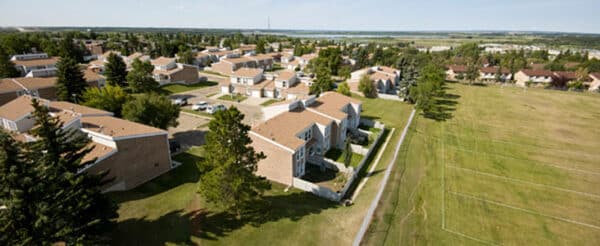Generally, no one should be able to trespass on your property if you already own it or are planning to buy one in the near future. However, boundary difficulties do arise, there will always be disagreements about where the lines should be drawn, and they can be quite unpleasant. A situation whereby property owners unlawfully enter, extend, or build onto their neighbor’s land. When this kind of problem arises, it is called “encroachment in real estate”. An encroachment may include trees, parts of buildings, fencing, or any other fixtures on both properties. While encroachment is usually deliberate and normally occurs when neighbors don’t get along, the government can also encroach on private property, of course. In this article, we detailed everything you need to know about encroachment in real estate, examples, and some helpful tips.
Have fun reading….
What Is Encroachment?
In real estate, an encroachment occurs when a property owner intentionally or unintentionally violates the property rights of a neighbor by building on or expanding a structure onto the neighbor’s land or property. A neighbor’s encroachment on someone’s property rights.
In other words, encroachment in the real estate world is an unlawful entry, construction, or extension of structures onto the land of another without consent. Generally, it is common for encroachment to occur along disputed property lines where a person intentionally chooses to violate his neighbor’s boundaries. Likewise, it may occur when a property owner is unaware of their boundaries.
Nevertheless, a property owner who violates their neighbor’s contractual property rights, whether intentionally or unintentionally, faces liability.
On the contrary, you can determine that your neighbor’s intrusion is unobtrusive and take no action. This option has the advantage of preserving goodwill between you and your neighbor. However, if you ever want to sell your property, you will need to disclose the encroachment to any potential buyers. This is for the potential buyer to be able to consider the issue as part of their purchasing decision.
Understanding How Encroachment Real Estate Work
Homeownership necessitates regular property and land surveys when they buy a house. This process, which is carried out by professional surveyors helps establish the property’s official lines and boundaries. Generally, when getting a mortgage is the first time many homeowners get a survey done. This, however, is because lenders expect them to make sure that the loan amount reflects the worth of the property. On the other hand, a homeowner can also request a new survey at any time. This might be useful especially if there is a disagreement amongst neighbors or encroaching on a property owner’s boundaries.
Meanwhile, because your property borders are established by a survey, anything your neighbor constructs on or over your line may be deemed an encroachment and it’s illegal. Regardless, trespassing is the act of invading another person’s property without their express permission. And, it is the same thing as encroaching on theirs. Basically, construction, additions, or fence extensions that go beyond the legally established boundaries between two properties constitute encroachment in real estate.
While encroachment in real estate can happen on purpose or accidentally, it always occurs without consent. There are many instances where property owners are either unaware of or incorrectly informed about their legal borders, leading to encroachment. Encroachment can be as minor as permitting a tree to grow over your property border. Or as significant as constructing a construction that extends beyond your property lines.
In many circumstances, merely chatting with your neighbor can remedy an incursion. In more serious circumstances, however, a court proceeding may be necessary, with a judge ordering the removal of the offending structure.
Types of Encroachment in Real Estate
Basically, there are minor and major encroachments that might take place between neighbors. But, there may also be a construction encroachment.
#1. Minor Encroachment
In most cases, a minor encroachment has little impact on the neighbor’s property rights. There are situations where the encroachment isn’t going to cause or lead to any problems. Just a few inches, for example, can separate a garden from a fence. So, it could be a temporary and very minor issue, like a plant or shrub growing across the boundary line.
A minor real estate encroachment is not uncommon. Normally, when a buyer’s lender does a property survey, they are more likely to detect them. Talking to your neighbor and agreeing on the best course of action is typically all that is necessary in these cases.
#2. Major Encroachment
This kinda encroachment in real estate can have a significant influence on the value of the property and the liabilities of the owner. In other words, there are a number of property encroachment issues that should raise a signal. This however may include building a garage or part of a house on your property. Likewise, an overhang or a tree limb that reaches onto your property from your neighbor’s land can also provide a problem. Even though the tree is in your neighbor’s yard, legal action may be necessary to remove encroaching structures in some circumstances.
Basically, it’s important to think about the consequences in case either of these structures were to fall and cause significant damage or perhaps death. So, you may have to file a claim against your homeowner’s insurance policy, even if there’s a way to settle encroachment amicably.
In addition, if you decide to sell your home in the future, this will affect its value. This is especially if there are more permanent constructions developed beyond your property’s boundaries.
#3. Construction/Stuctural Encroachment
Construction or structural encroachment happens when a property owner constructs anything on land they don’t own. However, despite the fact that these kinds of conflicts typically emerge between neighbors, they might also involve municipalities. And since roadways and sidewalks are often owned by the city and used by the public, this could be between the property owner and a municipality.
A typical example of a structural encroachment is an overhanging deck or balcony that extends beyond the property line of a neighboring property. Likewise, it could be an upper deck or balcony that extends into your property. Garages or sheds would also fall in this category. However, you need to make sure you solve all these issues before you acquire a house. Especially one with a shed or garage that is built in an improper place.
Meanwhile, it is in your best interest to address issues like this. Leaving them unaddressed on the other hand may lead to financial difficulties in the future. Also, they could have a negative impact on your ability to sell at a high price.
Easement and Encroachment in Real Estate
The term “easement” is used instead of “encroachment” when a property owner offers their neighbor permission to expand or develop on their property.
It’s simply a difference in communication and agreement between the neighbors that separates the two scenarios. Nearly all easement requests include some form of restitution to the adjacent owner for the inconvenience.
Encroachment Real Estate Examples
In general, there are various examples of encroachment cases in real estate; there may be a property encroachment on a neighbor’s yard by a property owner. This could simply be an intentional or unintentional expansion of their garden or the construction of an additional fence. A large-scale expansion or construction of a new structure on a neighbor’s property is possible in particular instances.
- Entering a neighbor’s land without permission to enter, trespass, or walk across it.
- Putting a fence that extends into your neighbor’s yard.
- Being able to have a tree or hedge whose branches run across property lines
- Building or extending structures onto your neighbor’s property or land
- The construction and/or erection of structures on publicly owned land (e.g., roads and sidewalks).
- Construction that is not government-owned that crosses property limits
- Uninformed government construction projects that cross private property lines.
Precautions Taken to Prevent Encroachment
Legal penalties can basically be severe for violating contractual property law. On the other hand, knowing how to avoid encroachment before purchasing land is helpful. Hence, the following tips can be a helpful hint to prevent and avoid encroachment.
#1. Real-Estate Assets Survey
In order to avoid any concerns with encroachment while purchasing a new home, it is beneficial to hire someone to survey the property.
#2. Awareness of one’s own personal property
Encroachment can happen by mistake in some cases. This may be due to this lack of knowledge. As a result, property owners may construct constructions on the land of their neighbors. While this may be without their neighbors’ consent or knowledge of the contractual property rights.
#3. Recognizing the boundaries of one’s own property
If you’re doing it on your own land, you don’t have to get permission to build or extend structures. However, it is important for property owners to know exactly where their neighbor’s property lines are. So that they do not inadvertently encroach onto theirs.
Solution/Control for a Real Estate Encroachment
Fortunately, there are several options available for dealing with an encroachment. However, it will be a good idea to make sure you know where your borders, as well as property lines, are. Getting the wrong information can alter your discussions with your neighbors which is what you wouldn’t want. Also, you do not want to provoke any rifts due to erroneous boundaries. So, keep this before you start a conversation with your neighbor.
#1. Talk to Your Next-Door Neighbor.
Generally, small issues like overlapping gardens can constitute encroachment. So, as a first step, talking to your neighbor calmly about the problem can be the best way to fix it. As such, he/she may be able to shift the structure, or you may be able to come up with a different solution. Besides, you and your partner can save money and worry by resolving any problems outside of court, rather than in court. This could nevertheless be a viable option for both parties if they decide to keep the intrusion in place. Likewise, an adverse possession claim can be avoided if this is done in advance.
#2. Try Working Out a Compensation Package that Works for Both
The other party may be willing to negotiate financial compensation and land arrangements in exchange for a necessary structure extension. Hence, you will need to purchase the permission to build on your neighbor’s land with compensation.
#3. Purchase or Sell Land
Another remedy is selling the entire parcel of land to the opposing party. This may be a viable option for the party being encroached upon. Even if your neighbor refuses to stop the encroachment, you may want to explore selling the land to them in order to resolve the problem. By doing this, your neighbor will be able to enjoy their land without having to worry about you. However, to ensure that all land records are valid and up to date, it’s a good idea to contact your mortgage lender before making a sale. At the same time, a local real estate lawyer can assist you with the preparation of all of this paperwork.
#4. Take the Matter to Court
Taking legal action to recover damages from the person or entity responsible for the incursion is the best course of action if they refuse to cooperate. If everything else fails, removing an incursion may necessitate legal action. Most of the time, you’ll have to show that you own the property in question. While your neighbor is abusing it and should be evicted. You can use A “quiet title” action to accomplish the first purpose. While an “eviction action” is used to accomplish the second.
However, this is a time-consuming process that often results in a poor relationship with your neighbors. Besides, it’s possible you’ll even go down to the wire. And while an adverse possession action may be possible, it is more probable that the court will award your neighbor limited use of the property. This however is if they have been using it inappropriately for some time, otherwise known as a “prescriptive easement”.
What Steps Should You Take To Prevent Encroachment?
Discuss your legal problem with an actual lawyer. You can file a complaint with your local government about his encroachment and property damage. In addition, you have the option to report him to the police (in accordance with the MRTP Act) along with the individuals responsible for the construction.
Is Trespassing the Same as Encroachment?
Trespassing typically refers to unauthorized access to another person’s property. On the other hand, a structure or other physical object that illegally protrudes or invades another person’s land is referred to as an encroachment.
What Effects Does Incursion Have?
The pace and amount of runoff, the loading of sediment and other pollutants, and the temperature of the receiving water all rise as a result of encroachment, which increases the impermeable cover next to lakes, rivers, and wetlands.
What Is an Issue with Encroachment on Land?
Encroachment of land occurs when a building or other permanent structure crosses over into another block of land from its owner. When purchasing a home, purchasers must be cautious about encroachment.
Conclusion
Generally, there are many ways in which incorrect information in a property survey might lead to a physical invasion of another owner’s land. This may include the measurement of metes as well as bounds. Although property owners may not be aware of encroachment, they should exercise caution before installing any constructions that may fall close to the boundary between their land and the property of others. Talk to your neighbors or get a carry out a land survey if you plan on making any improvements to your property near your neighbors’ property lines.
Encroachment Real Estate FAQs
Is it legal to encroach on someone's property?
If you’re infringing on someone else’s property, you’re breaching that person’s property rights. As a result, they are a crime.
What is the purpose of a "Encroachment Agreement?"
It is one of the simplest ways to resolve boundary concerns with a neighboring property. The contract will explain the encroachment and identify who owns the encroaching improvement. Adverse possession could result if the invading party agrees that, despite using the neighbor’s land, they will not make a claim of ownership in the future.
Is an Encroachment Worth It?
You should always double-check your property lines before making any changes to your property, whether it’s adding a structure or allowing a garden or tree to grow beyond its current boundaries.
Trespassing vs. Encroachment: What's the Difference?
A trespasser is someone who enters someone else’s property without permission; an encroachment is someone who is intruding upon their land without permission. Encroachment isn’t merely a violation of the law, but it also alters the property’s legal standing.
Related Articles
- PROPERTY SURVEY: How To Get A Property Survey & How Much It Costs
- DEED RESTRICTIONS: Definition & How to Identify Deed Restrictions On A Property
- Survey Companies: The Ultimate 2022 List With Reviews(Updated)
- CONDEMNATION REAL ESTATE: Definition & Laws
- Easement in Gross: Definition and Practical Example for any Business






